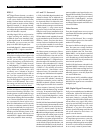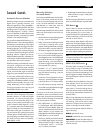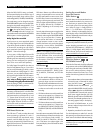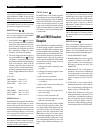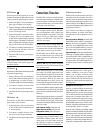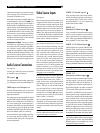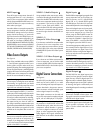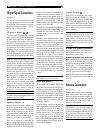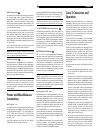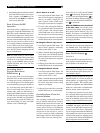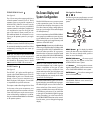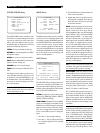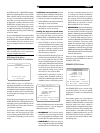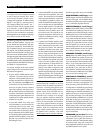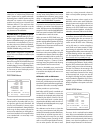
24
RSX-1055 Surround Sound Receiver
Output Signal Connections
See Figure 3.
This section of the manual describes the au-
dio and video signal output connections on
the RSX-1055. These are used for routing the
output signals to television monitors, audio am-
plifiers, and recording devices.
TV Monitor Output
The video output of the RSX-1055 sends the
video signal to your TV monitor. Three types
of video output connections are provided –
RCA composite video, S-Video, and Compo-
nent Video. Choose the type of video output
connection that matches the type of video input
connections you have made. Connect the TV
MONITOR
output
, from either RCA compos-
ite or S-Video or Component Video connec-
tor, to the corresponding
input
on your televi-
sion monitor, using appropriate video cables.
NOTE
: The RCA composite video output only
sends signals from RCA composite video
source inputs to the TV monitor. The S-Video
output only sends signals from S-Video video
source inputs to the TV. The Component Video
output only sends signals from Component
Video source inputs to the TV. If you have
connected all of your source components with
the same type of connection, then you only
need to make one connection from the
RSX-1055 to the TV monitor. However, in a
mixed system with, for example, some S-Video
and some RCA composite inputs, you will
need to make two connections to the TV moni-
tor and use its input selector to switch be-
tween the two when changing sources.
NOTE
: The ON-SCREEN DISPLAY system is not
available when using Component Video con-
nections to the TV monitor
Speaker Outputs
The RSX-1055 has five built-in amplifiers, two
for the front (right and left), one for the center
channel, and two for the rear surround speakers
(right and left). There are five pairs of bind-
ing post connections (one pair for each speaker)
which accept bare wire, spade lugs, or ba-
nana plug connectors (in some markets).
Each pair of connectors is color-coded for
polarity: red/blue/green for positive and black
for negative. All speakers and all speaker wire
is also marked for polarity. For proper perfor-
mance, you must maintain this polarity at all
speaker connections. Always connect the
positive terminal of each speaker to the cor-
responding colored (red/blue/green) speaker
terminal on the RSX-1055 and the negative
speaker terminal to the corresponding black
connector on the RSX-1055.
Each pair of connectors is labeled (FRONT L,
FRONT R, SURROUND L, SURROUND R, and
CENTER). You must connect each of the five
speakers to the proper terminal on the
RSX-1055.
Route the wires from the RSX-1055 to the speak-
ers. Leave enough slack so you can move the
components to allow access to the speaker con-
nectors. If you are using banana plugs, con-
nect them to the wires and then plug into the
backs of the binding posts. The collars of the
binding posts should be screwed in all the way
(clockwise). If you are using terminal lugs,
connect them to the wires. If you are attach-
ing bare wires directly to the binding posts,
separate the wire conductors and strip back
the insulation from the end of each conduc-
tor. Be careful not to cut into the wire strands.
Unscrew the binding post collars. Place the
connector lug or the twisted bare wire around
the binding post shaft. Turn the collars clock-
wise to clamp the connector lug or wire firmly
in place.
NOTE
: Be sure that no loose wire strands can
touch adjacent wires or connectors.
Center Back Speakers
The RSX-1055 has a “redirect” feature that
allows you to use the front left and front right
amplifier channels to power center back speak-
ers. For example, you might use a high-per-
formance separate Rotel stereo power ampli-
fier to drive the front speakers and use the five
RSX-1055 internal amplifier channels to power
the center, right surround, left surround, and
center back speakers.
To use this feature, connect the left and right
center back speakers to the front left and front
right speaker connections on the RSX-1055
rear panel. If you only have one center back
speaker, connect it to L/1 front speaker posi-
tion and leave the other set of front connec-
tions unused. Then, go to the SPEAKER SETUP
screen of the ON-SCREEN MENU system and
change the REDIRECT line to Center Back (CB
SP) instead of FRONT SP.
Preamp Outputs
There are ten RCA preamp audio outputs:
FRONT (LEFT/ RIGHT), CENTER (1/2), SUR-
ROUND REAR (LEFT/RIGHT), CENTER BACK
(CB1/CB2), and SUBWOOFER (1/2). Use
these outputs to send the RSX-1055’s output
signals to powered speakers or external am-
plifiers used in place of one or more of the
internal amplifiers.
NOTE
: Depending on your system configura-
tion, you may use some or all of these con-
nections. For example, if you only have one
center channel, you would connect it to the
CENTER 1 output. If you only have one cen-
ter back channel, you would connect it to the
CB1 output.
To hook up a powered subwoofer,
connect a standard RCA audio cable from the
SUBWOOFER OUTPUT jack to the input on
the subwoofer’s power amp.
To hook up the RCA main audio out-
puts, connect an audio cable from each
output
to the
input
of the amplifier channel that will
power the corresponding speaker. In a full home
theater system, you will need to make six dif-
ferent connections corresponding to the six
speakers (left front, center front, right front, left
surround, right surround, and subwoofer).
Make sure that you have each output connected
to the correct amplifier channel (front right, left
rear, etc.).
Antenna Connections
See Figure 6.
The RSX-1055 requires two antennas to receive
radio signals, one for AM and one for FM.
Most users will get acceptable reception us-
ing the indoor antennas which are supplied
with the RSX-1055. Instructions for hooking
up these antennas follow.
NOTE
: If you are some distance from the ra-
dio transmitters, you may use an outdoor an-
tenna to improve reception. Outdoor antenna
systems can be dangerous if they are not prop-
erly grounded and should be installed by a
professional contractor familiar with the elec-
trical code requirements in your local area.



